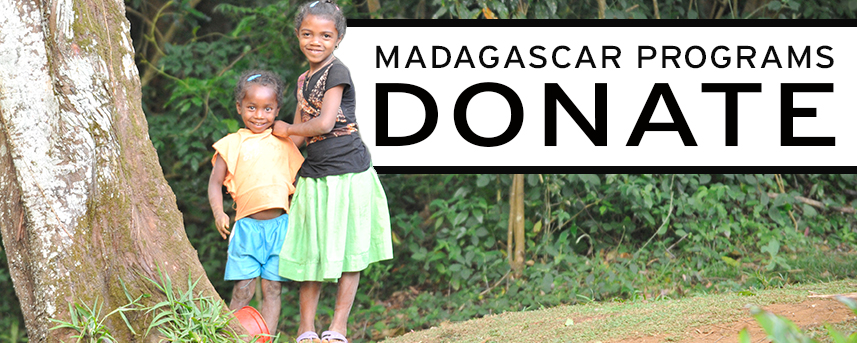By James Herrera, Ph.D., DLC-SAVA Program Coordinator
Reforestation is a mainstay of many conservation programs. The reason is that natural habitats, especially forests, have been degraded and destroyed by human activities. To restore those landscapes, planting trees is one step towards bringing back the diverse life that once existed. Reforestation is not a panacea, however; it is a part of a sustainability and conservation package. Our priorities should still include protecting primary forests, allowing the natural regeneration of habitat, as well as reforestation, if it is deemed appropriate and necessary.
In Madagascar, the natural habitats are rich with endemic biodiversity. Rainforests cover the mountains in the east, dry deciduous forests spread out across the western plains, wooded savannahs stud the central plateau, and a seemingly impenetrable spiny thicket in the south. Since the 1950s, over 7 million hectares (17 million acres) of forest were lost, due almost entirely to human activities. In an effort to restore the landscape, the government and people of Madagascar have declared a goal: to cover Madagascar in forest.

The goal is to cover Madagascar in forest.
To reach this goal, they will plant 60 million trees over the next four years. They had a successful start in 2020, despite the economic crisis caused by the corona virus pandemic. In the northeast, the Duke Lemur Center hosts a conservation program in the SAVA region (stands for Sambava-Andapa-Vohemar-Antalaha, the four main districts). We have partnerships with several actors in the region to help support these reforestation efforts. Thus far, over 100,000 trees were planted by different actors, and we have big plans for 2021.
Multiple actors are gearing up for the 2021 planting campaign. One of the DLC’s chief partners is the local university, Centre Universitaire Régional de la SAVA, or CURSA for short. CURSA hosts a reforestation plantation in the nearby countryside for the communities and students. The plot will be a mixed-use “food forest”, focusing on native trees as well as fruit bearing trees and agroforestry. Their goal is to demonstrate the value of trees on the agricultural landscape, for the incredible services they provide like securing and regenerating the soil, protect crops from wind, creating habitat for beneficial biodiversity, and more. By mixing native and fruit trees, the university will generate produce from the plantation. They plan to sell the fruit to generate income for the university and increase their sustainability.

Fruit trees, like avocados, and native forest trees are grown in nurseries and later planted in reforestation plantations.
Another motivated group that is making great strides towards reforestation and the restoration of natural forests is the local branch of the military. They have dedicated a part of the land on their base to reforestation. While they had previously tried to farm the land, they found the soil too degraded and unproductive, and decided they would use the land to contribute to the national reforestation campaign. Last year, they planted over 20,000 seedlings on almost 20 hectares (~50 acres) of their land, with a variety of native forest trees. They have agreed that they have almost 100 hectares that they want to dedicate to further reforestation. They do not currently have access to the quantities of seedlings or seeds they will need to achieve their goal. They also fear that their plantation is at risk, because most of the grasslands around it are being burned by farmers in preparation for planting. They plan to create a fire-break, which is a lane cleared of vegetation that prevents wildfires from spreading into the plantation. They do not have a budget for this activity, however, and would need to pay local community members to help complete the difficult work by hand. They have reached out to the DLC to let us know about their ambitions and the solutions to obstacles they envision for their restoration effort.

Local community members help to clear a firebreak at one of the reforestation plantations, Andranotsara, Antalaha District. DLC-SAVA and CURSA collaborated with the local communities to execute this site maintenance.
DLC is partnering with five such plantations this year to support their efforts and see their goals achieved. Each partner will plant 10 -15,000 seedlings in January 2021 to kick-start the year. DLC and CURSA will work closely with the communities to conduct the crucial maintenance and monitoring steps that are necessary for successful project implementation. We are striving to support these efforts through grants and donor support. We are also in the planning stages of a carbon credit program, which will allow the communities to earn money for the carbon that is being stored in the trees planted in Madagascar. Until then, all our project activities are supported by grants and donations. On average, it costs $1 to plant a tree in Madagascar. Consider helping our partners in Madagascar meet their goals.

Partnering closely with local actors, we can realize the goal of reforesting Madagascar while also improving agriculture and livelihoods for local communities.
The DLC’s conservation projects in Madagascar are run exclusively on grants and donor funding. Please consider making a tax-deductible donation today.


